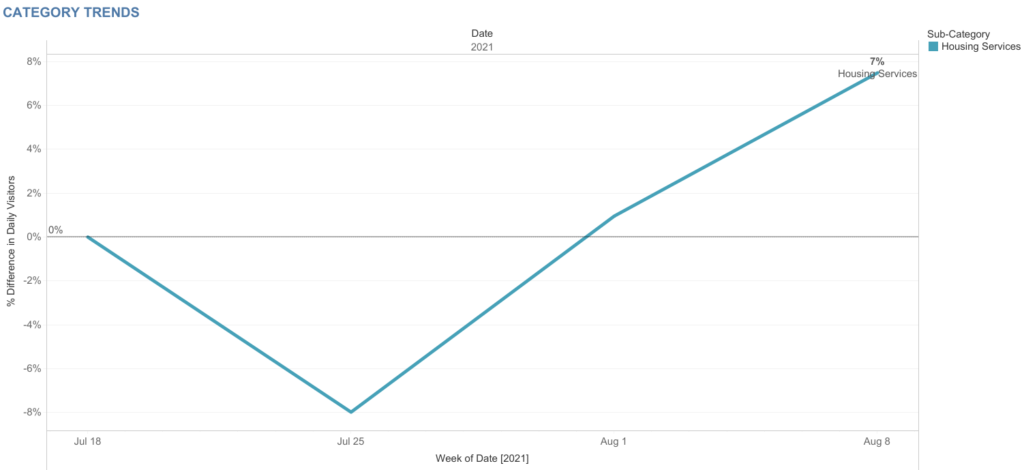How Did the Start of the School Year Impact the Housing Market?
October 4, 2021

Traditionally, the back-to-school season is known for causing an increase in demand in real estate, since many parents often opt to move before the school year starts. Recently, the housing and rental market has gotten an extra boost due to the coronavirus pandemic as many people gained the flexibility to work from home and took the opportunity to relocate. However, with the school year starting again and some people returning to work at offices, this trend might shift.
Are people still moving this far into 2021, or are they staying put now that the new school year is upon us? To find out, we analyzed visits to housing services, such as real estate businesses, moving companies, property management and maintenance companies, and apartment referral services during the start of the back-to-school season.

New School Year, New Home
For the week of August 8, 2021, visits to housing services across the U.S. were 7% higher compared to the week of July 18. This may indicate that consumers decided to look into renting or purchasing a new living space before the new school year started in late August. Some schools may have already started in late July and this could explain why less consumers were interested in the housing market during the last week of the month.

Housing Market & New School Year in the U.S.
Housing Market By State
For the week of August 8, 2021, foot traffic to housing services in Hawaii (+40%), D.C. (+38%), and Connecticut (+42%) was significantly higher, compared to the week of July 18.
Hawaii’s foot traffic numbers aren’t very surprising, considering the fact that remote workers have been flocking to the islands since the onset of the coronavirus pandemic and that doesn’t seem to be letting up any time soon, even during the start of the school year.
After the mass exodus of 2020, D.C. is witnessing the return of its former residents. This could be prompted by people returning back to the office after a year spent working from elsewhere and school starting up again. Many D.C. residents moved away from the city and into the suburbs or back to their hometowns.
In Connecticut, the increase in visits to housing services isn’t too surprising; Hartford Mayor Luke Bronin said that the newfound enthusiasm for Connecticut is due to the quality of life that exists in the state, a lower cost of doing business as compared to New York City or Boston, and a pool of talented and available employees, according to a recent article by the Journal Enquirer. This, in turn, can influence an influx of new students attending Connecticut school systems.
Consumers living in Arkansas (-29%), Wyoming (-23%), and Idaho (-19%) saw the least consumer interest in housing services. The reasons for these differences are vast and varied, but it could be because there is generally less housing available in rural areas, and while people would have opted to live in these areas during the pandemic, the return to school (and the office) has changed that dramatically.

Housing Market By City
In 2020 during the coronavirus pandemic, Fort Lauderdale, FL, saw a boom in home buyers and people relocating to the area. This year, visits to housing services in the city were 39% lower for the week of August 1, compared to the week of July 18. Why would this be the case? Many people may have moved to the city before July and August before school started.
On the other hand, Charlotte, NC, has recently experienced a housing boom, seeing a 98% increase in foot traffic for the week of August 8, 2021, compared to the week of July 18. This impressive increase could be due in part to Apple and Google recently announcing their plans to build offices close to Charlotte, bringing tech workers to the city in droves. As more people move to Charlotte, it can only be expected that there will be more students attending schools in the city.

Predicting Consumer Trends with Location Intelligence
Based on our data, we predict that foot traffic to housing services will continue to increase as people move toward new jobs and opportunities, or opt for a better lifestyle that suits their remote work needs. Eventually, it may plateau due to seasonality during the fall and winter as students get further into the school year and consumers monitor the status of the housing market and home prices.
If you’re interested in learning more about location intelligence and the most up-to-date consumer trends for your industry, schedule some time to speak with the experts at Gravy Analytics.




